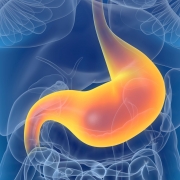Slower Eating Helps You Eat Less and Lose Weight
Everything is fast. Now life needs to be 5G, supercharged, and express. But your meals shouldn’t be a sprint. In fact, slower eating might actually crank up your weight-management efforts.
Try to think about the last time it took you 20 minutes or more to eat a meal. If it wasn’t recently, you may be scarfing your food down too fast. That’s because the 20 minute mark is important.
Science shows that it takes 20 minutes for your brain to get the message you’re full. Eating slower can help you feel full sooner. This eliminates the unintended, extra calories consumed after you’re actually full—but don’t know it.
So, instead of spending a lot of time thinking about the right mix of macronutrients or counting calories, just take more time to eat. This simple approach is just one of your options, obviously. Dieters use hundreds of different methods to try and reduce food intake. But eating slower might be worth trying on its own, or in combination with the diet of your choice.
Wondering if eating slower can really help you manage your weight? You aren’t alone. Researchers around the world have taken quite an interest in the topic of slower eating. Let’s see what they’ve found.
And the Slower Eating Study Says …
A lot of promising results have come out of all the research on eating slower and weight management. Some research has shown eating slower can help reduce food intake, which is great for weight-management.
You don’t have to seek out all the research yourself. A meta-analysis (a study of studies) published in the American Journal of Clinical Nutrition in 2014 did it for you. The study analyzed differences in eating rate and its influence on energy intake and hunger.
Researchers analyzed and combined the evidence from 22 studies. They calculated the average differences in food intake between slow and fast eating, and the possible differences in hunger.
The combined evidence showed that eating slower is associated with less calorie consumption than a faster eating rate. This was true regardless of the type of manipulation used to alter the eating rate. But how fast eating was done did not have an impact on hunger.
This review supports the idea that the rate of eating does affect energy intake. Eating slower will help reduce food intake and limit excess consumption, regardless of the method used to slow down eating rate. You’ll see some of those methods a little bit later.
How Does Eating Slower Make You Lose Weight?
Research on pace of eating has found correlations between lower body mass indexes and slower eating. That’s exciting. But why does it happen?
The lower calorie consumption for slower eaters is obviously a key part. Eating fewer calories is probably the most well-established weight-management advice. And you’ve already seen how eating slower ties to decreased caloric intake.
You eat slower, you tend to eat less. That’s mostly because you feel full before you overeat. Go back to the fun fact from earlier in the story. It takes 20 minutes for your brain to figure out if you’re full or how full you really are. So, if you eat a meal’s worth of food in 10 minutes and keep going for another five minutes, then you took in a lot of extra calories.
But research suggests the links between eating slower and weight go deeper than the simple math of calories.
The habit of inhaling food at a fast pace has established ties to metabolic issues. This revolves around how fast eaters’ bodies react to food—including glucose tolerance issues and insulin resistance. These connections aren’t surprising. Maintaining your metabolic health and staying at a healthy weight go hand in hand.
And eating slower could help you keep your metabolism and fat burning churning normally, as well as help you eat fewer overall calories. That’s a good combination for weight management. As a bonus, a study in Japan found that eating slower helps you better digest your food.
The Right Pace to Feed Your Face
There’s been far more studies on the reasons to eat slower than on the pace that’s right for weight management. It’s not easy to figure out how to categorize your eating—too fast, too slow, just right.
One study from the University of Rhode Island introduced numbers into the conversation about pace of eating:
- Fast eating: about 3.1 ounces of food per minute
- Medium eating: about 2.5 ounces per minute
- Slow eating: about 2 ounces per minute
The numbers are helpful. But you don’t have to weigh everything you eat and break it down into two-ounce segments. There are easier ways to figure out the right pace to slow the flow of food into your stomach.
The simplest solution—use chewing as your pacing mechanism.
The more you chew, the slower you’ll eat. Counting the number of chews per bite, and aiming for 15-20, will help you hit the sweet spot for eating slower.
You can also time your chewing. One study found that 30 seconds of chewing helped study participants eat half as much candy as they would have when chewing normally.
No matter how you find the right pace for you, remember the 20-minute magic number. Eat at a leisurely pace to stretch the meal out enough for your brain to catch up to your mouth.
How to Eat Slower
Pacing yourself is good advice. But it’s kind of vague, right? There has to be a few practical pointers to achieve the right pace.
Actually, there is. You’re about to read six tips for eating slower. They can help you use slower eating to manage your weight. But they might even help your digestion and bring more enjoyment to your meals.
- Chew with purpose. You read about chewing in the pacing section above. But it’s worth repeating: chewing each bite more, and doing it slowly, helps properly adjust your pace. Try chewing each bite at least 20 times. You’ll slow yourself down and prepare your food better for digestion. If you’d rather time your chewing than count each chomp, go for 15 seconds or more.
- Take smaller bites. Chewing slow is great. But if you eat your meal in seven or eight huge chunks, your pace will still be too fast. Reducing the size of your bites, combined with purposeful chewing, helps you eat slower.
- Engage your senses. Taste is the sense most associated with food. But taking time to really enjoy how your food looks, and paying attention to texture (feeling) can also help slow eating. The most important might be smelling, though. Taste and smell are companions. Getting a good whiff, and enjoying the aromas will enhance your eating experience and throttle back your speedy eating.
- Break between bites. Intentionally pausing after each bite slows the speed of your meals. Do this by putting down your fork or spoon between bites—or setting down the food if it’s handheld.
- Listen to your body. Hunger is physical. You can feel it. There are signs when you need food, and different ones when you’ve had enough. Take time to check in with what your body is saying. And don’t disregard the signs because there’s more on your plate.
- Change your food mindset. Food is many things. At its most basic, it’s fuel. But food is also emotion and family and pleasure and intellectual stimulation and much more. So, don’t just treat food like the gas you dump in your car quickly so you can race down the road. Focus on each bite. Savor it. Discuss it. And really embrace and enjoy the full experience of eating.
References
“A Simple Way to Eat More Slowly.” Shape Magazine online.
“Ask the Diet Doctor: The Ideal Eating Pace.” Shape Magazine online.
“Here’s Why Eating More Slowly May Help You Lose Weight.” Time Magazine online.
“How to Eat Slower: 6 Strategies.” Psychology Today online.
“I Spent 2 Weeks Trying to Eat More Slowly—Here’s How It Went.” Cooking Light online.










